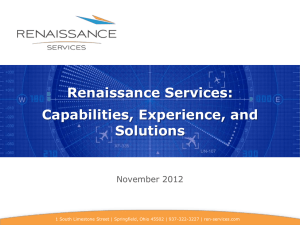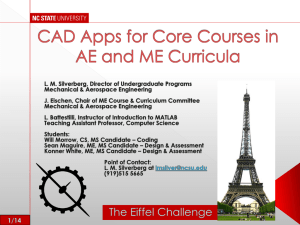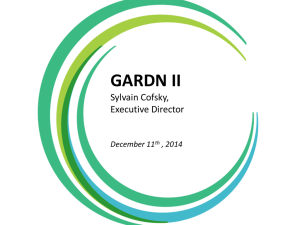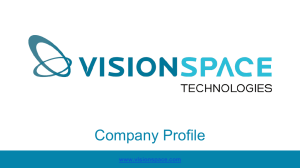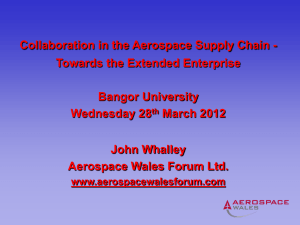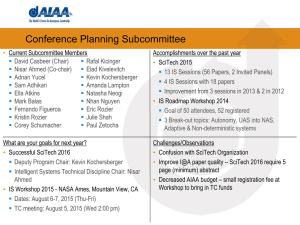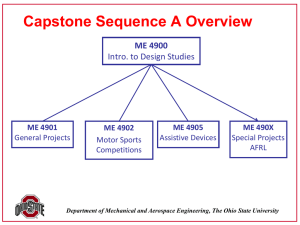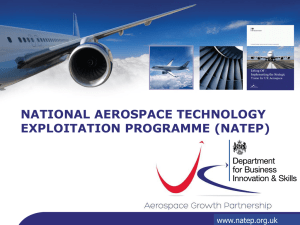RMITSAMMEMay2012
advertisement
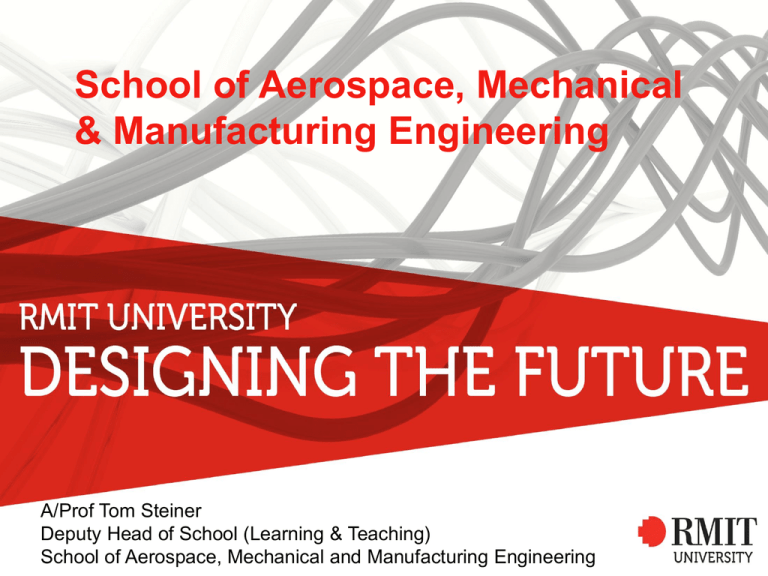
School of Aerospace, Mechanical
& Manufacturing Engineering
A/Prof Tom Steiner
Deputy Head of School (Learning & Teaching)
School of Aerospace, Mechanical and Manufacturing Engineering
ABOUT THE SCHOOL
•
Our School is the largest Higher Education Engineering School at RMIT.
• The School is based in the City and Bundoora East Campus, with
offerings in Singapore & Hong Kong (from September 2012).
•
Students with highest ATAR score in Engineering at RMIT
•
Disciplines:
Aerospace & Aviation
Mechanical & Automotive Engineering
Manufacturing & Materials Engineering
•
Special features:
One of Australia’s oldest and most prestigious Aerospace programs
First Automotive Engineering degree in Australia
FISITA World Champion Formula SAE team
First Australian Hydrogen powered racing car
Applied focus with strong fundamentals; PBL approach
RMIT University©
2
School of Aerospace,
OVERVIEW - STATISTICS
•
•
Staff and students:
Approx. 100 staff (over 60 academics and 12 full-time research staff)
Approx. 1500 students total, and around 100 PhD students
Number of UG programs (HE) comprising:
- 6 Single Degrees
- 2 Double Degrees (with 5 new DDs from 2013)
•
Number of PG programs (HE) comprising:
- 6 PG by coursework programs (GC, GD, Master) + 1 new one
from 2013
- 3 x Masters by Research programs
- 3 x PhD programs
RMIT University©
School of Aerospace, Mechanical & Manufacturing Eng
3
IS ENGINEERING RIGHT FOR YOU?
If you like
– Solving practical problems,
– Designing useful things,
– Having the opportunity to make an
impact on the future,
– Discovering new things and innovating,
– Working with new technologies, and
– Working with people, and
– Mathematics and Sciences
…. then engineering could be a good
choice for you.
• Our graduates tell us that they really enjoy
their work!
– very good employment rates, with
competitive salaries,
School of Aerospace, Mechanical & Manufacturing Engineering
– opportunities to travel and work
overseas.
SAMME presentation to marketing staff – 09 March 2012
4
WHAT DO ENGINEERS DO?
• Engineers apply science and technology to solve real-world problems that
affect people.
• Engineers:
– Design & develop engineered systems (hardware, software, processes),
– Undertake research at the cutting edge of engineering science,
– Solve major problems that confront our society like mobility, climate
change, water shortage, etc.,
– Provide specialist consultancy services,
– Manage organisations that have strong interests in technology.
• Engineers work in companies that
– Design & manufacture,
– Build & install,
– Project manage and advise,
– Investigate & develop
School of Aerospace, Mechanical & Manufacturing Engineering
– Work locally, nationally, and internationally
SAMME presentation to marketing staff – 09 March 2012
5
ABOUT THE SCHOOL OF AEROSPACE, MECHANICAL
& MANUFACTURING ENGINEERING (SAMME)
• SAMME is the home for areas related to “mechanical” technologies and their
applications, like aerospace, automotive and manufacturing. It is the largest
Engineering School at RMIT, and one of the largest in Australia.
• Our engineering programs allow students to explore diverse areas from green
technologies to sports engineering, advanced manufacturing technologies to
aerospace and automotive design and development.
• Practical and industry-focussed approach – our graduates are extremely
employable worldwide.
• We are old and we are young – at RMIT we’ve been educating engineers for
many decades, but we continually improve what we do and how we do it to
keep fresh and up-to-date
• RMIT Mechanical Engineering research ranked “Above World Standard” in
last ERA review.
School of Aerospace, Mechanical & Manufacturing Engineering
• RMIT is consistently ranked in the top 100 universities in the world for
engineering and science (Times Higher Education QS ranking)
SAMME presentation to marketing staff – 09 March 2012
6
INDUSTRY ENGAGEMENT … just a few of our partners
We have strong partnerships with industry in Australia and worldwide.
Boeing Focus University
RMIT is a Boeing Focus University.
This reflects a high level of industry engagement
and recognition from the global Aerospace
Sector.
RMIT-LMS Noise Vibration
Harshness Lab
RMIT-SAGE Automation
Training Centre
School of Aerospace, Mechanical & Manufacturing Engineering
SAMME presentation to marketing staff – 09 March 2012
7
AEROSPACE ENGINEERING
Bachelor Degree programs
(City & Bundoora):
1. BEng (Aerospace) – 4 years
2. BEng (Aerospace)/BBus. (Management) – 5
years
Key Features:
RMIT CT4
Aircraft
•
Comprehensive program in aerospace
engineering
•
Industry focused specialisations in:
– Aircraft design (incl. UAVs)
– Aircraft structures & materials
– Aircraft propulsion
Student tour of
School of Aerospace, Mechanical & Manufacturing Engineering
– Aerodynamics
– Through-life support of ageing aircraft
– Spacecraft systems, etc
SAMME presentation to marketing staff – 09 March 2012
NASA
8
MECHANICAL ENGINEERING
Bachelor Degree programs
(City & Bundoora):
1.
BEng (Mechanical) – 4 years
2.
BEng (Mechanical)/BBus (Management) – 5 years
Key Features:
•
Provides the widest range of professional career
paths in many industries
•
High demand for our graduates – around 83%
employment immediately upon graduation
•
Industry focused specialisations in:
– Renewable Energy & Energy Conservation
– Computer Aided Engineering & Product Design
– Mechatronics, Dynamics & Control
– Industrial Aerodynamics School
& Computational
Fluid
of Aerospace, Mechanical
& Manufacturing Engineering
Dynamics
SAMME presentation to marketing staff – 09 March 2012
9
AUTOMOTIVE ENGINEERING
BEng (Automotive) – 4 years (City & Bundoora)
Key features:
• The first automotive degree in Australia
• Strongly supported by the Car Industry nationally
and internationally
• Global Employment opportunities for graduates
• Exciting project work (eg Formula SAE-A)
• Mix of hands-on and engineering analysis
leading to expertise in
Vehicle Aerodynamics and Styling
Vehicle Power Systems
Vehicle Handling and Control
Computational Engineering
Motor Vehicle Design
School of Aerospace, Mechanical & Manufacturing Engineering
Vehicle Noise and Vibration Harshness
Motorsport engineering
RMIT Open Day 14 August 2011
10
FSAE-A Car (a great example of experiential learning)
Won the European Event in 2004,
Overall USA winner and Australian winner in 2006,
FISITA World Champion in 2007.
5th in Detroit, USA in 2008.
School of Aerospace, Mechanical & Manufacturing Engineering
SAMME presentation to marketing staff – 09 March 2012
11
Formula Hydrogen
Australia’s First Hydrogen Powered Racing Car
School of Aerospace, Mechanical & Manufacturing Engineering
SAMME presentation to marketing staff – 09 March 2012
12
MANUFACTURING ENGINEERING & MECHATRONICS
Bachelor of Engineering (Advanced Manufacturing & Mechatronics) – 4 years
Advanced
Manufacturing
Prepares our students
to tackle all system
control, supply chain,
lean manufacturing,
workplace management
issues.
Mechatronics & Robotics
Materials Engineering
Prepares our students to
develop sophisticated
computer controlled
manufacturing facilities to
improve productivity,
quality, mass
customisation.
Prepares our students
to handle complex
materials related
manufacturing issues
causing problems in
quality, reliability,
serviceability,
product
School of Aerospace, Mechanical & Manufacturing Engineering
development.
SAMME presentation to marketing staff – 09 March 2012
13
SUSTAINABLE SYSTEMS ENGINEERING
Bachelor Degree program (City & Bundoora):
BEng (Sustainable Systems) – 4 years
Key Features:
Incorporates the fundamentals of engineering:
• Mathematics
• Engineering Design
• Professional Practice and Engineering sciences
• Sustainable systems approach
• Hands-on learning in studios as well as classes
Specialist streams in:
– Sustainable Transportation Systems
– Sustainable Energy Systems
– Sustainable Logistics Systems
School of Aerospace, Mechanical & Manufacturing Engineering
SAMME presentation to marketing staff – 09 March 2012
14
AVIATION
(note: this is not an engineering program)
Bachelor of Applied Science (Aviation) – 3 years (City)
Focus is on aviation industry operational planning and
management, including:
• Introduction to Aircraft & Aviation Industry
Environment
• Human Factors in Aviation
• Aviation Safety Systems & Quality Systems
• Professional Practice & Project Management
• Airport Operations & Airline Operations
Graduate opportunities:
• Airline operations, planning & management
• Airline maintenance management
• Airport operations, planning
& management
School of Aerospace, Mechanical & Manufacturing Engineering
• Aviation safety & Aviation consultancy
RMIT Open Day 14 August 2011
15
NEW DOUBLE DEGREE PROGRAMS FROM 2013
New double bachelor degree programs starting in 2013, each combining two
excellent degrees to create powerful industry-focussed programs:
•
BEng (Automotive)/BBus (Management) (City & Bundoora), 5 years
•
BEng (Mechanical)/BSc (Biotechnology)
(City & Bundoora), 5 years
•
BAppSc (Aviation)/BBus (Management)
(City & Bundoora), 4 years
•
BEng (Mechanical)/BDes (Industrial Design)
•
BEng (Advanced Manufacturing & Mechatronics)/BBus (International Business)
(City & Bundoora), 5 years
(City & Bundoora), 5 years
School of Aerospace, Mechanical & Manufacturing Engineering
Double degree programs offer a wider range of career paths, and often with
higher salaries.
SAMME presentation to marketing staff – 09 March 2012
16
Your study program at RMIT University
All Engineering programs in Australia are of 4 years duration –
at RMIT engineering programs generally have year themes:
•Year 1: the basics tools of engineering science; an introduction to
your chosen discipline
•Year 2: further engineering science and application; the beginnings
of real design work
•Year 3: getting into advanced analysis; more advanced design;
electives. Vacation employment in preparation for fourth year.
•Year 4: advanced design; research project; electives. Preparation
for the professional engineering workplace.
SAMME presentation to marketing staff – 09 March 2012
How will the program develop you as a professional
engineer, and what should a student look for?
– What should you look for?
• Educational style (how do you learn to apply theory, develop skills for
design and communication as well as practice teamwork and leadership)
• How will the university develop your career path? Additional
opportunities such as placements, study abroad/exchange,
undergraduate research opportunities, leadership training, etc
• Does the university have a good reputation for the area of engineering
you want to study?
• University Rankings can be misleading {e.g A focus on research
publications by academic staff has nothing to do with quality of
undergraduate teaching! }
SPECIAL FEATURES ENGINEERING PROGRAMS
•
Local/international work opportunities with an optional paid industrial
placement offered within the program locally, in Europe or USA.
•
Opportunities for excellent exchange & study abroad experiences.
•
Focus on application through project-based learning (PBL) and workintegrated learning (WIL) … starting in the 1st semester.
•
Access to the Advanced Manufacturing Precinct to support design
learning
•
Many of final year students’ projects are done in cooperation with
industry. Increasing participation by industry is being pursued.
•
Around 20 students work each year on the RMIT-NORTHLink
Greenhouse and Energy Efficiency Program with around 15 companies
to achieve set targets in CO2 reduction.
•
Students have the opportunity to work each year on the Formula SAE
School of Aerospace, Mechanical & Manufacturing Engineering
racer.
•
Access to CT4 Aircraft for flight experiments.
SAMME presentation to marketing staff – 09 March 2012
19
EXPERIENTIAL LEARNING
We are developing new laboratories with industry to provide high quality
environments for collaborative learning, training, and applied research:
•
LMS Centre of Expertise in Vehicle Noise Vibration Harshness
•
SAGE Automation Training Centre
•
Aerospace Structures Laboratory
Our students benefit from a range of experiential learning opportunities
which put their studies into a realistic and applied context. Examples
include:
•
Automotive challenges - Hydrogen car, electric car, SAE Racer
•
Experimentation using a real aircraft - CT4
•
Applied learning via automation training facility, renewable energy park, etc.
•
Design studios
RMIT University©
20
School of Aerospace,
Quality Assurance of engineering education in Australia
• Accreditation of undergraduate engineering programs by Engineers Australia.
• “Washington Accord” – provides reciprocal recognition of accredited
engineering qualifications in 20 countries (includes Australia, Malaysia,
Singapore, USA, UK, Korea, Japan, Germany, etc.)
As well as these two above, the following QA measures benefit all students
• ESOS (Educational Services for Overseas Students) – Government Act to
ensure quality of delivery of education to overseas students studying in
Australia on a student visa.
• Student experience surveys conducted by universities and the government.
SAMME presentation to marketing staff – 09 March 2012
Student Projects and Activities
AIAA International
Design Competition
Computer Aided Manufacturing
School
of Aerospace,
Project
work Mechanical & Manufacturing Engineering
Formula SAE
in 2nd year
SAMME presentation to marketing staff – 09 March 2012
Mobile robots
22
Our graduates have excellent career opportunities for work in a
wide range of areas including:
• Aerospace design, manufacture & testing
• Automotive design, manufacture & testing
• Building services engineering
• Engineering management
• General manufacture
• Materials handling systems in packaging & mining industries
• Power & Petrochemical industries
• Product development
• Research & Development
• Energy efficiency and renewable energy
….. and so on …..
School of Aerospace, Mechanical & Manufacturing Engineering
SAMME presentation to marketing staff – 09 March 2012
23
GREEN CAREERS IN ENGINEERING
• Sustainability – a significant growth area for employment
– sustainable energy (i.e. energy efficiency and demand management, and
renewables),
– sustainable manufacturing, recycling and waste recovery and reuse, and
– sustainable water supply and use
• Drivers for growth in ‘green jobs’ & “sustainability literacy” in engineering and
aviation include:
– Climate change and the need to meet national and global greenhouse gas
emission reduction targets
– Peaking of global oil supply and associated price instabilities
– Adverse environmental impacts of resource-intensive industries and
transport
– The need to conserve all non-renewable resources (energy, minerals and
living species and ecosystems) to achieve sustainable development
School of Aerospace, Mechanical & Manufacturing Engineering
SAMME presentation to marketing staff – 09 March 2012
24
Green career opportunities
Main sectors for engineering graduates:
• Sustainable energy industry, e.g:
– Energy efficiency and demand management (energy managers , energy
consultants, cogeneration specialists)
– Solar thermal (heating, passive solar buildings, power generation)
– Photovoltaic systems
– Alternative technologies development and implementation - Wind power,
Bio-fuels, Geothermal, Wave and tidal power
• Sustainable energy and sustainability specialists in existing manufacturing,
primary industries and building management
• Government departments and agencies with interest in sustainability
- federal, state and local government
• International agencies supporting sustainable development projects in the
Asia-Pacific region and the developing world generally (e.g. World Bank,
Asian Development Bank, United Nations)
School of Aerospace, Mechanical & Manufacturing Engineering
• Non-government organisations such as environmental groups and
aid organisations (e.g. World Wildlife Fund, Oxfam, Community Aid Abroad)
SAMME presentation to marketing staff – 09 March 2012
25
Entrance Requirements
Current Year 12:
Prerequisites: Units 3 & 4 (English – any), and Mathematical Methods
(either)
Bonus points:
•
A study score of at least 25 in Specialist Maths = 1 point.
•
A study score of at least 25 in Chemistry or Physics = 1 point (to maximum
of 1 point)
Non Year 12:
Applicants are encouraged to apply and may be required to have relevant
employment or evidence of experience and/or ability to meet the demands
of the program.
School of Aerospace, Mechanical & Manufacturing Engineering
SAMME presentation to marketing staff – 09 March 2012
26
Clearly-in ATAR Scores for students starting in 2011
Program
VTAC
Code
Clearly-In
ENTER
B App Sci (Aviation)
32911
80.35
B Eng (Aerospace)
32481
88.40
B Eng (Aerospace)/B Bus (Management)
32041
95.05
B Eng (Automotive)
31021
88.00
B Eng (Adv Manufacturing & Mechatronics)
31661
80.10
B Eng (Mechanical)
31761
84.20
B Eng (Mechanical)/B Bus (Management)
31691
90.50
School of Aerospace, Mechanical & Manufacturing Engineering
SAMME presentation to marketing staff – 09 March 2012
27
Pathways
Graduates of the TAFE programs listed below may be eligible to apply for
exemptions of up to two years from a four year Bachelor of Engineering
program, depending on academic performance:
1. Associate Degree in Engineering Technology (Mechanical)
or
2. Advanced Diploma of Engineering Technology (Mechanical/Manufacturing),
followed by
Advanced Diploma of Engineering Technology (Principal Technical Officer)
School of Aerospace, Mechanical & Manufacturing Engineering
SAMME presentation to marketing staff – 09 March 2012
28
POSTGRADUATE COURSEWORK PROGRAMS
Our postgraduate coursework programs cover a wide range
of areas, each of which is very relevant to industry:
• Sustainable Energy
• Aviation Management
• International Automotive Engineering
• Systems Support Engineering
• Integrated Logistics Management
• Engineering Management
• Manufacturing
RMIT University©
29
School of Aerospace,
QUESTIONS?
School of Aerospace, Mechanical & Manufacturing Engineering
SAMME presentation to marketing staff – 09 March 2012
30
